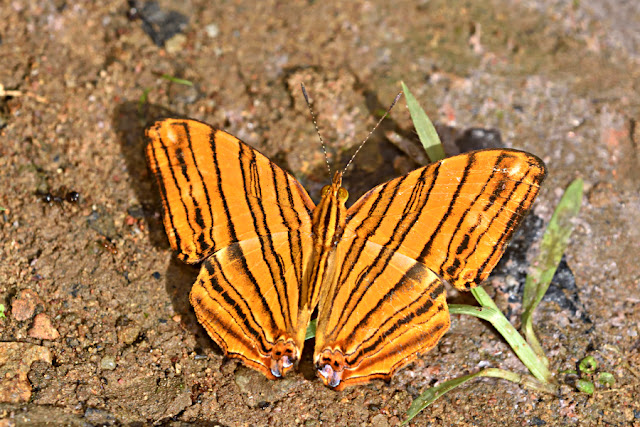The Leaf Butterfly (Kallima inachus) is shaped like a dry leaf and its underside wings blend very well with the ground and its preferred habitat.
Occasionally, it flapped its wings rather erratically, giving us an opportunity to shoot its attractive iridescence on the uppersides.
Another specimen - the markings, the size and the position of black spots on the undersides often vary. If you want to read more about the foraging behavior of this butterfly, read this journal article.
The Lavender Count (Cynitia cocytus cocytus) presented a nice perch in front of me at Chiangdao.
I only sighted one Eastern Courtier (Sephisa Chandra Chandra) at Doi Inthanon this time. Very often we encountered the males visiting damp ground to imbibe nutrient solutions. 

We didn't get to see many Nawab butterflies this trip. This Pallid Nawab (Polyura arja) was hooked on the ground for a long period of time.
A common species in Chiangmai, this conspicuous Great Nawab (Polyura eudamippus nigrobasalis) is a permanent resident of Chiangdao.
The Shan Nawab (Polyura nepenthes nepenthes) is another magnificent and common butterfly.At one moment, the two Nawabs were side-by-side with their wings partially open.
With patience, I managed to snap their uppersides. So do you see the slight differences between these two species?
The Black Rajah (Charaxes solon sulphureus) was less common this time - it appeared only once at Chaingdao.
The predominant blue iridescence of the upper wings of the Constable (Dichorragia nesimachus) are quite unique.
I noticed that the Indian Purple Emperor (Mimathyma ambica miranda) is abundant in certain months of the year in Chiangdao. A medium size fast-flyer in the subfamily Apaturinae, this species was often sighted puddling on the moist ground.
Both sexes look alike. The upper wings of the male present an intense blue iridescence when we photograph it at a certain angle.
Last shot for this post is another member of the Apaturinae subfamily - the Naga Emperor (Chitoria naga) an uncommon species in Thailand.
I believed there were two different individuals at a high altitude in Chiangdao.
In my next post, I will share pictures of butterflies in the Satyrinae subfamily.
In the mean time, wishing every reader of the blog a Merry Christmas and a Fruitful New Year ahead.

















































